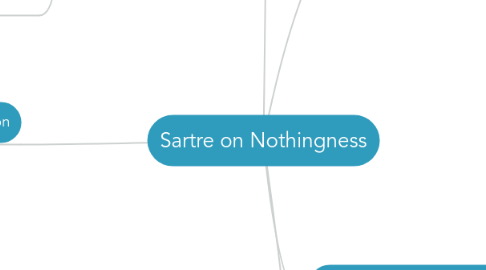Sartre on Nothingness
作者:Anna Bromely


1. Realism and Idealism
1.1. Defined a position (Pursuit of Being) which transcends these two alternatives
1.2. S takes realism to involve a commitment to 3 claims: 1.Consciousness contains representations of objects in the world 2.Representations and their objects are independent of one another 3.Representations are caused by those objects Realism must be false as consciousness contains no representations, is not independent of its objects, cannot form representations through the impinging of objects Realism must be false as consciousness contains no representations, is not independent of its objects, cannot form representations through the impinging of objects
1.3. The idealist rejects any reference to to a mind independent world. However, there are other conceptions of realism and idealism E.g. Kant's brand. But Husserl and S both reject the realm of unknowable things in themselves , The things we perceive are transphenomenal (cannot be reduced to their being being perceived).
2. Sartre's Theory of Imagination
2.1. Consciousness is the origin of nothingness. Imagination involves a negation of reality. Negate the objects of ones present consciousness. Consciousness has the power to negate or nihilate. Negation is intrinsic to structure of intentionality. Con must differentiate itself from the object, otherwise it would collapse into it and lose its identity as consciousness.
3. 4 more accounts of nothingness
3.1. Psychological The nothingness experienced in the cafe is not a psychological state.
3.2. Logical Nothingness is not the result of a mental or logical act. Does not account for an encounter with a perceived absence/lack.
3.3. Hegal's account Being and nothing are opposed categories which join to form becoming. S thinks nothingness loses its character and is reduced to a kind of emptiness, whilst remaining on par with being. Being an nothingness are asymmetrical, even through reality contains them both.
3.4. Heidegger's account Nothingness comes into the world as a consequence of the upsurge of Dasein. Doesn't state how nothingness comes about. S claims that humans bring nothingness into world because they themselves contain it.
3.4.1. Introduction - why are you writing about this?
3.4.2. Subhead 1
3.4.3. Subhead 2
3.4.4. Subhead 3
3.4.5. Conclusion - what summarizes what is most interesting about your topic?
4. Nothing
4.1. Nothing is the idea of the 'negation of the totality of beings'. -Nothing cannot be made into an object for us. -Negation is not a specific act of the intellect, independent of the nothing. -The nothing is more original than the 'not' and negation. -The nothing concerns the ensemble of of beings, it negates beings as a whole.
4.2. Anxiety is the mood in which the founding mode of attunement (Dasein) encounters nothing. Anxiety reveals the nothing. The nothing reveals itself in and trough anxiety.
4.3. Heidegger describes the nothing as the shadow of Being. It is a condition for being to reveal itself.
4.3.1. Inspire someone about your topic?
4.3.2. Specific grade?
4.3.3. Do your best work?
